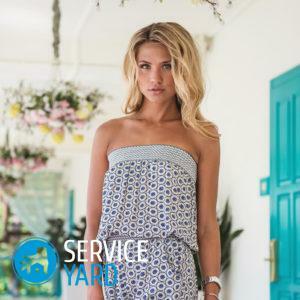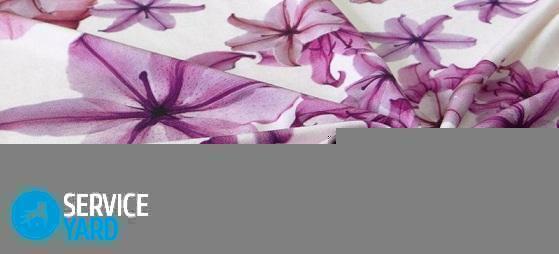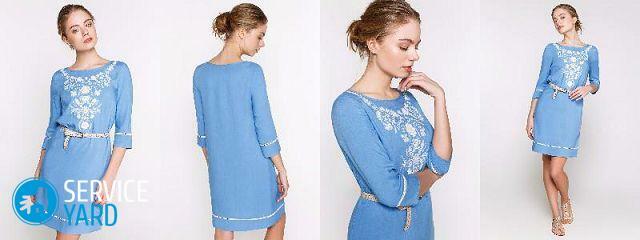
- What kind of fabric is viscose?
- Characteristics, properties and types of viscose
- Viscose material - advantages:
- Viscose cloth care
Every self-respecting fashionista, choosing her outfit, first of all draws attention to what he sews. After all, clothing is not only an ornament, but first of all protection from various environmental factors: air temperature, humidity, ultraviolet. Choosing clothes for ourselves, we take into account fashion trends, time of year, age, and not least pay attention to the fabric. Mankind is increasingly striving for a healthy lifestyle, naturalness, so we buy clothes more pleasant for our body, which does not harm our body. Often we choose flax, cotton, silk, wool. What is our surprise when on the label we read "Viscose."Yes, viscose is a synthetics that can replace natural fabrics, not only in appearance, but also in properties. Let's see, viscose drags on or not and what is this viscose material.
to the contents ↑What kind of viscose cloth?
Viscose appeared in the nineteenth century, thanks to the persistence of the French chemical engineer. Scientists for many years tried to produce a material that would have natural properties and at the same time was very durable. In 1884, Guiller de Chardonnay conducted a series of studies, which resulted in the emergence of an artificial material from natural raw materials - viscose.

This was a truly revolutionary invention, allowing the use of waste wood industry - sawdust, for the production of a universal substance. The question arises, the viscose material - what is it, is it a natural substance or synthetics?
Manufacturing technology
This material is made of wood, based on cellulose. Wood sawdust is converted into a liquid substance by chemical reaction, which is cooked under high pressure for 24 hours with a solution of calcium hydrosulfite. Then they are forced through special molds. Depending on the diameter of the holes, either filaments or a film are obtained. Of these, there are already created paintings that are used for tailoring.
to the table of contents ↑Characteristics, properties and types of viscose
The modern industry produces technical and textile fibers of viscose. Depending on the mode of production of fiber, the properties and type of tissues can be very different. Also, the quality of the tissue can be affected by various additives. Therefore, there is a logical question, the material of viscose - what is it and stretches viscose or not. Consider the main types of such tissue.
100% natural viscose
Very soft, quickly wearing material. In dry form, a stronger fiber than in wet. The quality can resemble cotton, has increased hygroscopicity.
Cotton with viscose
For strength in cotton viscose fiber is added. Because of this, the fabric can shrink to 16-18%.In the wet form, such a cloth half loses its strength.
Stapling
Short fibers add fabrics of greater elasticity. Therefore, this material is beautifully draped, does not crumble so much. It is possible to paint not only in monochrome color, but also apply a pattern. Very successfully staple is used for sewing flared dresses, long, wide skirts, lush blouses.
Knitted
The properties of such a fabric make it possible to produce high-quality knit fabrics from these fibers for the production of T-shirts, knitwear for children, sweaters, and linen. It is such a viscose stretches.

Viscose with elastane
In order to increase the elasticity of the fabric, elastane fibers are added to it in small amounts: 5% elastane, 95% viscose. In order to check whether viscose stretches, you can try to stretch your sports suit: the elasticity of this material helps to create sportswear, a different kind of knitwear, which does not bind the body and provides freedom of movement.
"
" oil fabric Last time is very popular among manufacturers and consumers alike. When adding polyester to viscose, a very soft, durable and pleasant cloth for the body is obtained. Owners of a good figure can easily choose this fabric for sewing evening fitting dresses, flowing skirts, flying blousons.
Lining
Viscose is the most successful option for the manufacture of the lining, because it does not deform during wear, absorbs moisture well, protects the upper material, and also provides a presentable appearance to the inside of the product. Such fabric as a lining is used for sewing outerwear and hats.
"Stitch"
Quilted viscose is made of blankets, home textiles, products in the style of "Patchwork".The latest trendy trend offers us quilted dresses, jackets, coats, batniki, which not only look beautiful, but also very warm, comfortable to wear.
to Contents ↑Viscose Material - Advantages:
- Viscose is much lighter than cotton and wool.
- Fabric is well draped, soft.
- Unlike other materials, it can be used for both summer and winter wear. In winter it is warm, in summer it is quite cool.
- Hygroscopicity of viscose is 2 times higher than moisture absorption by cotton.
- Viscose viscose is similar to cotton by air permeability. In clothes from her body breathes, there is no "steam bath effect".
- Viscose is hypoallergenic.
- During static wear of viscose products static electricity does not accumulate.
- Meets high hygienic requirements.
- In dry form, viscose is very durable.
- The technology of fiber production allows it to be painted in various colors, introducing the dye immediately into the fiber. This prevents rapid washing, fading.
- Products from such a fabric do not shed.
- After washing very quickly dries.
- In comparison with other fabrics, such as natural silk, viscose is a democratic and inexpensive material.
- When burning fibers of this material, a characteristic smell of burnt paper is highlighted.
Disadvantages of fabric:
- Viscose without additives, in pure form very much drags, so products can be deformed.
- When washing, it can cause significant shrinkage.
- 100% viscose material is strongly crumbled on slices, in products requires additional processing.
- If you do not neatly wear the clothes, rolls, especially when in contact with other materials.
Viscose cloth care
Proceeding from the above, it is necessary to correctly handle products made of such a fabric:
- For clothes made of viscose, a wash mode is "delicate".
- The washing method is machine or manual.
- Water during washing and rinsing is not more than 30-40 degrees.
- Powders are desirable to choose without phosphate. And it is best to use soft gels for washing.
- Do not use the hard spin mode at high speed, because the wet cloth is not firm.
- Dry products better in a horizontal form, spread out on a terry towel or cotton sheet. Drying is best done away from heating appliances.
- Before you iron the product of this material, you need to turn it to the wrong side. Adjust the temperature of the iron to the "silk" mode. Do not use steam treatment, because it will irretrievably ruin the product.
We hope that a selection of our tips will help you to distinguish viscose from other materials, choose the fabric for the right product, depending on its properties, and with the help of proper care to prolong the life of your things.


